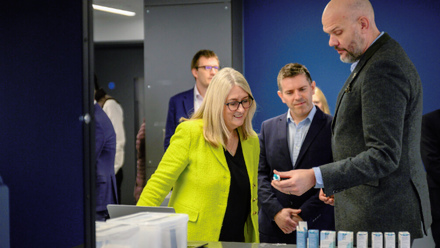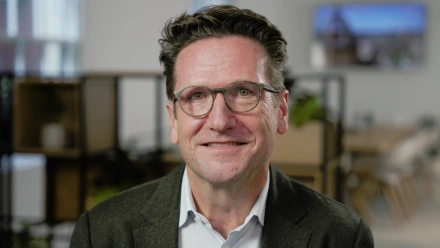London through my eyes - Neelam Patel, CEO, MedCity

Neelam Patel, CEO, MedCity
In this blog, MedCity CEO Neelam Patel expresses her pride in London's growth as a beacon for life sciences. Now stepping down from her role after nine years in the organisation’s leadership, Neelam takes this opportunity to share her reflections on London’s evolution as a life sciences supercluster, powered by innovation districts spread across the city.
Almost a decade ago, in 2014, I joined MedCity at its formation as the life sciences cluster organisation for London – working for the last four years as CEO. It has been a real privilege to be at the helm of an organisation that is unique in its ability to bring diverse stakeholders together to promote the growth of the health and life sciences sector, and, crucially, tackle barriers to that growth for the benefit of all. I am hugely proud of what the MedCity team, past and present have achieved over these years and our stakeholders and partners nationally and internationally that have supported our mission.
So, what have been my observations on London’s growth as a beacon for life sciences during my time at MedCity?
I am astounded by our Capital’s capacity for innovation.
Enthusiasm for innovation is everywhere in London, spread across the established and emerging innovation districts, from the Knowledge Quarter in central London to White City and Paddington Life Sciences in the west; Whitechapel, Canary Wharf and Olympic Park to the east; and SC1 and the Innovation Hub to the south.
Anchoring each of these districts is their world-leading life sciences assets – universities, NHS Trusts, research charities and institutions — enhanced by the entrepreneurs who chose to co-locate with them for knowledge-sharing and collaborative opportunities, and supported by local boroughs and real estate investors who contribute to shaping community interface and infrastructure.
The extent of this innovation should be celebrated, we have seen this in the race to overcome Covid-19 and are seeing this to tackle climate change. Investing in this entrepreneurialism and enabling it to scale across the UK and globally is how we can grow our economy, improve the health of our nation and be a Science Superpower.
London’s value in the national landscape, historically and still today, is its connectivity with the rest of the UK and the rest of the world. In life sciences, London has worked to provide linkages for entrepreneurs and organisations to other key centres in the UK, such as Stevenage with its expertise in cell and gene therapy manufacture, and the dispersed academic hubs of advanced therapy innovation that have been brought together as UK Advanced Therapies, an initiative that started in London.
This activity represents levelling up that is not often discussed – the connecting of actors across the UK life sciences ecosystem through knowledge networks for sharing best practice, making introductions to resource providers such as investors, and sign-posting international companies and organisations to locations across the UK with the capabilities that match their needs. This is spreading growth and not displacing it.
In 2016, we published our first life science demand report, since then, it has been remarkable that the demand for Real Estate and Infrastructure is shaping how large-scale life sciences development can co-exist with community regeneration and improved health outcomes.
Life science entrepreneurs, whether at start-up or later stage, have many reasons for gravitating to London. Access to talent, proximity to academic and clinical centres, transport connections, a vibrant, diverse cultural and social life, and Europe’s largest concentration of VCs are some of the city’s attractions. Indicative of growth in the number of life sciences companies who want to be in London, we have seen demand for lab space grow significantly between our first life sciences real estate demand study in 2016 and our most recent one in 2021.
As real estate developers and investors have intensified their activity in life sciences property, there is a risk that new space will not meet the needs of life science tenants – due to the specifications required for particular types of R&D or because the location is not optimal – leading to empty properties, lowering the return on investment, and leaving SMEs without labs. For this reason, we have worked closely with developers, local authorities, and SMEs to inform life sciences infrastructure.
Through challenges in location and planning, I have seen extraordinary collaboration pan-London for local authorities to work together to bring benefits of the right real estate development to not only SMEs, corporates, and investors, but also the local communities sitting alongside these mini-cities where universities nestle alongside hospitals, incubators and workspace. MedCity has helped to catalyse this cohesiveness. The future is enabling mobility between regions to allow communities to work, live and socialise across London’s innovation districts, spreading opportunities across the capital. There should be no boundaries in a unified life sciences economy.
Celebrating diversity as a life science asset, London is the most diverse city in Europe.
This population diversity is also an incredible asset for life sciences. It provides a unique opportunity to promote London, and the UK, as a destination for global commercial clinical trials. Recruiting a diverse patient population enables pharma and biotech to generate evidence that can be used for multi-market approvals. The benefits of life sciences clusters to communities are being demonstrated in the mature innovation clusters in London and these should be references for shared learning across the country.
The ability to convene and connect is now more important than ever. Over the past nine years, I have been part of a sea change in London’s evolution as a life sciences SUPERCLUSTER. London can no longer be thought of as a single life sciences cluster. We now have multiple innovation districts that separately, and together, are propelling the life sciences economy. The announcement of the government’s £650 million life sciences package comes at the right time to leverage the whole of the UK’s regional strengths for the benefit of all.






